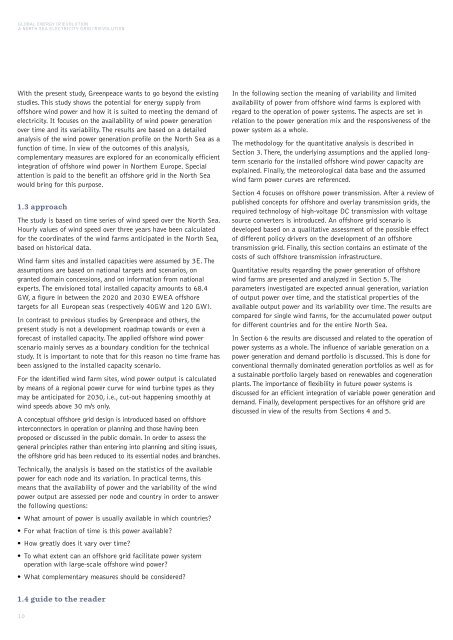offshore grids for wind power integration - Greenpeace
offshore grids for wind power integration - Greenpeace
offshore grids for wind power integration - Greenpeace
Create successful ePaper yourself
Turn your PDF publications into a flip-book with our unique Google optimized e-Paper software.
GLOBAL ENERGY [R]EVOLUTION<br />
A NORTH SEA ELECTRICITY GRID [R]EVOLUTION<br />
With the present study, <strong>Greenpeace</strong> wants to go beyond the existing<br />
studies.This study shows the potential <strong>for</strong> energy supply from<br />
<strong>offshore</strong> <strong>wind</strong> <strong>power</strong> and how it is suited to meeting the demand of<br />
electricity. It focuses on the availability of <strong>wind</strong> <strong>power</strong> generation<br />
over time and its variability.The results are based on a detailed<br />
analysis of the <strong>wind</strong> <strong>power</strong> generation profile on the North Sea as a<br />
function of time. In view of the outcomes of this analysis,<br />
complementary measures are explored <strong>for</strong> an economically efficient<br />
<strong>integration</strong> of <strong>offshore</strong> <strong>wind</strong> <strong>power</strong> in Northern Europe. Special<br />
attention is paid to the benefit an <strong>offshore</strong> grid in the North Sea<br />
would bring <strong>for</strong> this purpose.<br />
1.3 approach<br />
The study is based on time series of <strong>wind</strong> speed over the North Sea.<br />
Hourly values of <strong>wind</strong> speed over three years have been calculated<br />
<strong>for</strong> the coordinates of the <strong>wind</strong> farms anticipated in the North Sea,<br />
based on historical data.<br />
Wind farm sites and installed capacities were assumed by 3E.The<br />
assumptions are based on national targets and scenarios, on<br />
granted domain concessions, and on in<strong>for</strong>mation from national<br />
experts.The envisioned total installed capacity amounts to 68.4<br />
GW, a figure in between the 2020 and 2030 EWEA <strong>offshore</strong><br />
targets <strong>for</strong> all European seas (respectively 40GW and 120 GW).<br />
In contrast to previous studies by <strong>Greenpeace</strong> and others, the<br />
present study is not a development roadmap towards or even a<br />
<strong>for</strong>ecast of installed capacity.The applied <strong>offshore</strong> <strong>wind</strong> <strong>power</strong><br />
scenario mainly serves as a boundary condition <strong>for</strong> the technical<br />
study. It is important to note that <strong>for</strong> this reason no time frame has<br />
been assigned to the installed capacity scenario.<br />
For the identified <strong>wind</strong> farm sites, <strong>wind</strong> <strong>power</strong> output is calculated<br />
by means of a regional <strong>power</strong> curve <strong>for</strong> <strong>wind</strong> turbine types as they<br />
may be anticipated <strong>for</strong> 2030, i.e., cut-out happening smoothly at<br />
<strong>wind</strong> speeds above 30 m/s only.<br />
A conceptual <strong>offshore</strong> grid design is introduced based on <strong>offshore</strong><br />
interconnectors in operation or planning and those having been<br />
proposed or discussed in the public domain. In order to assess the<br />
general principles rather than entering into planning and siting issues,<br />
the <strong>offshore</strong> grid has been reduced to its essential nodes and branches.<br />
Technically, the analysis is based on the statistics of the available<br />
<strong>power</strong> <strong>for</strong> each node and its variation. In practical terms, this<br />
means that the availability of <strong>power</strong> and the variability of the <strong>wind</strong><br />
<strong>power</strong> output are assessed per node and country in order to answer<br />
the following questions:<br />
• What amount of <strong>power</strong> is usually available in which countries?<br />
• For what fraction of time is this <strong>power</strong> available?<br />
• How greatly does it vary over time?<br />
• To what extent can an <strong>offshore</strong> grid facilitate <strong>power</strong> system<br />
operation with large-scale <strong>offshore</strong> <strong>wind</strong> <strong>power</strong>?<br />
• What complementary measures should be considered?<br />
In the following section the meaning of variability and limited<br />
availability of <strong>power</strong> from <strong>offshore</strong> <strong>wind</strong> farms is explored with<br />
regard to the operation of <strong>power</strong> systems.The aspects are set in<br />
relation to the <strong>power</strong> generation mix and the responsiveness of the<br />
<strong>power</strong> system as a whole.<br />
The methodology <strong>for</strong> the quantitative analysis is described in<br />
Section 3.There, the underlying assumptions and the applied longterm<br />
scenario <strong>for</strong> the installed <strong>offshore</strong> <strong>wind</strong> <strong>power</strong> capacity are<br />
explained. Finally, the meteorological data base and the assumed<br />
<strong>wind</strong> farm <strong>power</strong> curves are referenced.<br />
Section 4 focuses on <strong>offshore</strong> <strong>power</strong> transmission. After a review of<br />
published concepts <strong>for</strong> <strong>offshore</strong> and overlay transmission <strong>grids</strong>, the<br />
required technology of high-voltage DC transmission with voltage<br />
source converters is introduced. An <strong>offshore</strong> grid scenario is<br />
developed based on a qualitative assessment of the possible effect<br />
of different policy drivers on the development of an <strong>offshore</strong><br />
transmission grid. Finally, this section contains an estimate of the<br />
costs of such <strong>offshore</strong> transmission infrastructure.<br />
Quantitative results regarding the <strong>power</strong> generation of <strong>offshore</strong><br />
<strong>wind</strong> farms are presented and analyzed in Section 5.The<br />
parameters investigated are expected annual generation, variation<br />
of output <strong>power</strong> over time, and the statistical properties of the<br />
available output <strong>power</strong> and its variability over time.The results are<br />
compared <strong>for</strong> single <strong>wind</strong> farms, <strong>for</strong> the accumulated <strong>power</strong> output<br />
<strong>for</strong> different countries and <strong>for</strong> the entire North Sea.<br />
In Section 6 the results are discussed and related to the operation of<br />
<strong>power</strong> systems as a whole.The influence of variable generation on a<br />
<strong>power</strong> generation and demand portfolio is discussed.This is done <strong>for</strong><br />
conventional thermally dominated generation portfolios as well as <strong>for</strong><br />
a sustainable portfolio largely based on renewables and cogeneration<br />
plants.The importance of flexibility in future <strong>power</strong> systems is<br />
discussed <strong>for</strong> an efficient <strong>integration</strong> of variable <strong>power</strong> generation and<br />
demand. Finally, development perspectives <strong>for</strong> an <strong>offshore</strong> grid are<br />
discussed in view of the results from Sections 4 and 5.<br />
1.4 guide to the reader<br />
10

















